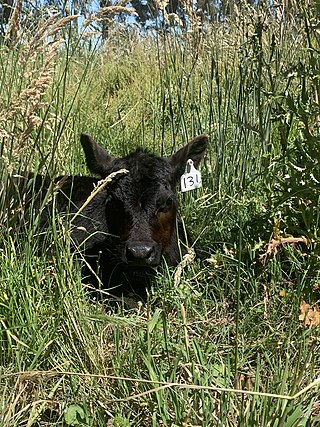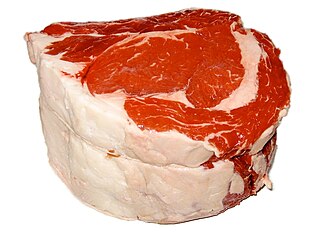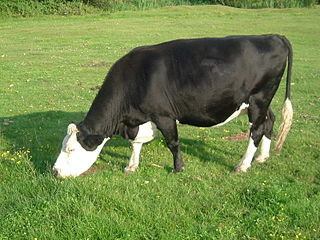
A calf is a young domestic cow or bull. Calves are reared to become adult cattle or are slaughtered for their meat, called veal, and their hide.

Veal is the meat of calves, in contrast to the beef from older cattle. Veal can be produced from a calf of either sex and any breed; however, most veal comes from young male calves of dairy breeds which are not used for breeding. Generally, veal is more expensive by weight than beef from older cattle. Veal production is a way to add value to dairy bull calves and to utilize whey solids, a byproduct from the manufacturing of cheese.

Beef is the culinary name for meat from cattle. Beef can be prepared in various ways; cuts are often used for steak, which can be cooked to varying degrees of doneness, while trimmings are often ground or minced, as found in most hamburgers. Beef contains protein, iron, and vitamin B12. Along with other kinds of red meat, high consumption is associated with an increased risk of colorectal cancer and coronary heart disease, especially when processed. Beef has a high environmental impact, being a primary driver of deforestation with the highest greenhouse gas emissions of any agricultural product.

The Ox is the second of the 12-year periodic sequence (cycle) of animals which appear in the Chinese zodiac related to the Chinese calendar, and also appears in related calendar systems. The Chinese term translated here as ox is in Chinese niú , a word generally referring to cows, bulls, or neutered types of the bovine family, such as common cattle or water buffalo. The zodiacal ox may be construed as male, female, neutered, hermaphroditic, and either singular or plural. The Year of the Ox is also denoted by the Earthly Branch symbol chǒu. The term "zodiac" ultimately derives from an Ancient Greek term referring to a "circle of little animals". There are also a yearly month of the ox and a daily hour of the ox. Years of the oxen (cows) are cyclically differentiated by correlation to the Heavenly Stems cycle, resulting in a repeating cycle of five years of the ox/cow, each ox/cow year also being associated with one of the Chinese wǔxíng, also known as the "five elements", or "phases": the "Five Phases" being Fire, Water, Wood, Metal, and Earth. The Year of the Ox follows after the Year of the Rat which happened in 2020 and is then followed by the Year of the Tiger, which happened in 2022.

A freemartin or free-martin is an infertile female cattle with masculinized behavior and non-functioning ovaries. Phenotypically, the animal appears female, but various aspects of female reproductive development are altered due to acquisition of anti-Müllerian hormone from the male twin. Genetically, the animal is chimeric: karyotypy of a sample of cells shows XX/XY chromosomes. The animal originates as a female (XX), but acquires the male (XY) component in utero by exchange of some cellular material from a male twin, via vascular connections between placentas: an example of microchimerism. The chimerism is mainly present in the hematopoietic stem cells.

Weaning is the process of gradually introducing an infant human or another mammal to what will be its adult diet while withdrawing the supply of its mother's milk.

The Holstein Friesian is an international breed or group of breeds of dairy cattle. It originated in the Dutch provinces of North Holland and Friesland and in Schleswig-Holstein in northern Germany. It is the dominant breed in industrial dairy farming worldwide, and is found in more than 160 countries. It is known by many names, among them Holstein, Friesian and Black and White.

Dairy cattle are cattle bred for the ability to produce large quantities of milk, from which dairy products are made. Dairy cattle generally are of the species Bos taurus.

An oxOKS, also known as a bullock, is a bovine, trained and used as a draft animal. Oxen are commonly castrated adult male cattle; castration inhibits testosterone and aggression, which makes the males docile and safer to work with. Cows or bulls may also be used in some areas.

Neospora is a single celled parasite of livestock and companion animals. It was not discovered until 1984 in Norway, where it was found in dogs. Neosporosis, the disease that affects cattle and companion animals, has a worldwide distribution. Neosporosis causes abortions in cattle and paralysis in companion animals. It is highly transmissible and some herds can have up to a 90% prevalence. Up to 33% of pregnancies can result in aborted fetuses on one dairy farm. In many countries this organism is the main cause of abortion in cattle. Neosporosis is now considered as a major cause of abortion in cattle worldwide. Many reliable diagnostic tests are commercially available. Neospora caninum does not appear to be infectious to humans. In dogs, Neospora caninum can cause neurological signs, especially in congenitally infected puppies, where it can form cysts in the central nervous system.
A carcass grade is an assessment of quality for a culled cow or bull. The various grades are defined by the United States Department of Agriculture, and assessments are based primarily on the fatness of the cow to be culled.

The Black Baldy is a type of cross-bred beef cattle. It is traditionally produced by crossing Hereford bulls on Aberdeen Angus cows.

The Black Hereford is a crossbreed of beef cattle produced in Britain and Ireland with Hereford beef bulls and Angus. Black Herefords are not usually maintained from generation to generation, but are constantly produced as a byproduct of a terminal cross. They are one of the most common types of beef cattle in Britain and Ireland, outnumbering many pure beef breeds.

Cattle are large, domesticated, bovid ungulates widely kept as livestock. They are prominent modern members of the subfamily Bovinae and the most widespread species of the genus Bos. Mature female cattle are called cows and mature male cattle are bulls. Young female cattle (heifers), young male cattle, and castrated male cattle (steers) are all colloquially called "cows".

A Bull is an intact adult male of the species Bos taurus (cattle). More muscular and aggressive than the females of the same species, bulls have long been an important symbol in many religions, including for sacrifices. These animals play a significant role in beef ranching, dairy farming, and a variety of sporting and cultural activities, including bullfighting and bull riding.

A cow calf operation is a method of rearing beef cattle in which a permanent herd of cows is kept by a farmer or rancher to produce calves for later sale. Cow–calf operations are one of the key aspects of the beef industry in the United States and many other countries. In the British Isles, a cow–calf operation may be known as a single-suckler herd. The goal of a cow–calf operation is to produce young beef cattle, which are usually sold. A rancher who works within such a model is often called a "cow–calf operator" in the United States.

Cattle slaughter in India, especially cow slaughter, is controversial because of cattle's status as endeared and respected living beings to adherents of Dharmic religions like Hinduism, Jainism, Buddhism and Sikhism; while being an acceptable source of meat for Muslims, Christians and Jews. Cow slaughter has been shunned for a number of reasons, specifically because of the cow's association with the god Krishna in Hinduism, and because cattle have been an integral part of rural livelihoods as an economic necessity. Cattle slaughter has also been opposed by various Indian religions because of the ethical principle of Ahimsa (non-violence) and the belief in the unity of all life. Legislation against cattle slaughter is in place throughout most states and territories of India.
Creep feeding is a method of supplementing the diet of young livestock, primarily in beef calves, by offering feed to animals who are still nursing. Creep feed is sometimes offered to swine, and it is possible with companion grazing animals such as sheep and goats. Creep feeding is used almost exclusively in situations where animal prices are high, feed costs are low, offspring are born in the spring, and the animals are purebred.

Vaccinations for cattle involves the process of applying subcutaneous injections of biological microorganisms in a weakened state to help the immune system develop protection by providing active acquirement of immunity to a particular disease. Cattle are bovine livestock and are thus very susceptible to diseases. Vaccinations for cattle are widely used in the livestock industries of the Australian agriculture sector by farmers to prevent harmful and deadly diseases from infecting their livestock, avoiding any economical or biological harm. Farmed livestock industries account for 45% of the gross value of Australian agricultural output, beef cattle being the largest farmed livestock nationally with around 26.2 million head of cattle nationwide. The beef industry within Australia generates a gross value of approximately $8 billion AUD in beef exports and a total gross value of $11.4 billion in farm production (2017–18). Thus, vaccinations play a vital role in protecting, sustaining and growing the beef cattle industry in the Australian agriculture sector.


















